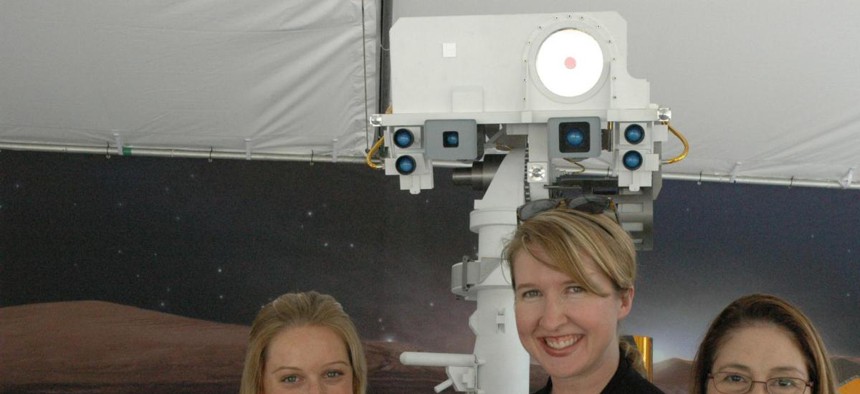The Women Behind Curiosity Rover's Tweets
Odds are your agency could learn a thing or two from this talented social media team at NASA.
It has been four years since the creation of the Mars Curiosity Twitter account, and one thing hasn’t changed – the witty rover’s still got it.
Behind the pop-culture-savvy, science-loving bot is a social media team brimming with ways to engage the public in NASA’s other-worldly exploration.
NASA’s Jet Propulsion Laboratorykeeps news and social media manager Veronica McGregor and social media specialists Courtney O’Connor and Stephanie L. Smith busy, running the social media accounts and public affairs for more than 20 flying missions.
McGregor has been a NASA news and social media guru the longest, joining the JPL team in 2001 after covering NASA for CNN.
O’Connor joined McGregor shortly after graduating as an early career hire in 2009 just as Curiosity was being built. She joined the team after working for Microsoft as a social media intern.
“I do think that the mission has a kind of special place in my heart,” O’Connor said. “I came on at the same time she was being built.”
Smith was the last to join the JPL social media team in 2010. Before working for NASA, Smith was the senior editor for the online division of Channel One News. She covered and translated many JPL stories for the news organization.
The women refer to the team as JPL’s social media “hivemind.” Scientists send data collected from Curiosity to the team to simplify complicated terminology, add a little spice and condense the information into 140 characters or less.
“It’s a little like writing science haiku,” Smith said. “We try to distill stories down to their essence, but also focus on how the science works, what’s going on and why it matters.”
And when these social media savvy team members don’t quite understand the information they’re supposed to tweet, O’Connor said help is never too far away.
“We also have really strong connections with the scientists and engineers,” O’Connor said. “We can email them with questions.”
The team said they try to accommodate everyone when it comes to catering tweets to followers. McGregor said they include “techy” and fun mentions in each tweet because some followers just want the funny headlines, while others want all the technical details. To keep tweets fresh, the team will throw in a song lyric with a Curiosity twist or refer to movies. She said tactics like these help keep the conversation going.
When Curiosity was undergoing software maintenance, the team had to decide how to condense the science into an interactive, fun and brief tweet. The Hivemind decided on a quirky Matrix reference.
“When curiosity was getting its brain transplant … we started thinking about ‘what are we going to tweet for that?’” McGregor said. “Half a second later, people were writing back saying ‘show me!'"

But as pop culture tweets gain a lot of attention, none has surpassed the landing night tweet, lovingly referred to as the “touchdown tweet” by the Curiosity team.

The touchdown tweet received nearly 72,000 retweets, the most the Twitter account has seen since creation.
“That’s Bieber level,” Smith said.
Along with her hefty retweets, Curiosity hauls in a lot of followers.
Curiosity has nabbed the No. 1 spot as JPL’s biggest account from previous leader,@AsteroidWatch. Since her launch, Curiosity has accumulated more than a million followers.

Because the tweeters behind the account are human, accidents occasionally happen. Typos and inaccurate information sometimes slip through the cracks, but the team said it doesn’t happen frequently.
O’Connor said the team is thankful that Twitter is very forgiving.
Blunders aside, Smith said it is important to connect with the public through social media communication.
“For a given tweet, we can trade off between huge metrics and personal interaction,” Smith said. “So the rover has tweets that go out to everyone, but it’s still responding to individual questions.”
McGregor said more than 50 percent of Curiosity postings are replies rather than the team pushing out new information.
With the social media boom, NASA not only increased its audience worldwide, but it also fostered a stronger relationship with the public.
“NASA had a pretty good reputation going in, but social media just makes it even easier,” McGregor said. “And I think people now feel they have a relationship with NASA.”
Curiosity’s Twitter team said fans should be on the lookout for results from recent science experiments on Mars.
“It’s a voyage of discovery!” Smith said. “So you never know what you’re going to find.”
In the meantime, fans are encouraged to wish JPL a happy birthday as it celebrates its 76th anniversary Wednesday.
Learn from experts, innovators and your peers about the impact of technology on the future of government programs and citizen outreach. Join us on December 3 in Washington DC for Nextgov Prime, the defining event in the federal technology landscape. Learn more at nextgov.com/prime





